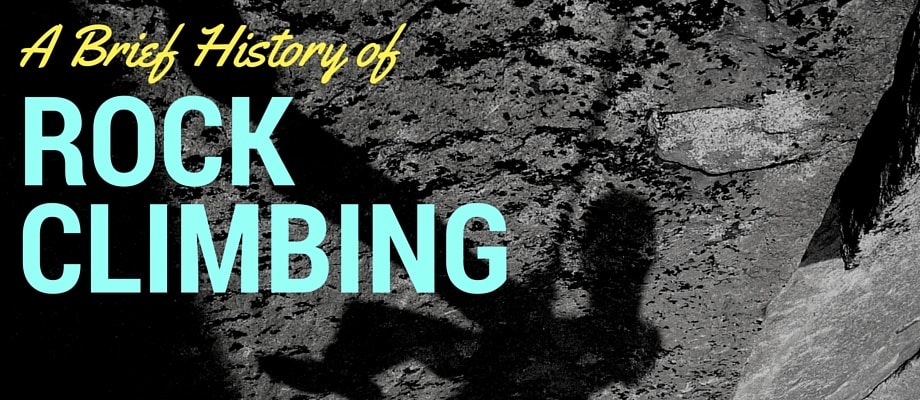
Prior to the evolution of modern rock climbing, the most daring ambitions revolved around peak-bagging in mountainous terrain. The concept of climbing a rock face, not necessarily reaching the top of the mountain, was a foreign concept that seemed trivial by comparison. However, by the late 1800s, rock climbing began to evolve into its very own sport. Read on for a brief history of rock climbing.
The early beginnings of rock climbing
There are 3 areas credited as the birthplace of rock climbing:
- Elbe Sandstone Mountains, Germany
- Lake District, England
- Dolomites, Italy
Meanwhile, in the United States, daring summits started trickling in by the country’s early climbing visionaries—including: John Muir’s on-sight free solo of Cathedral Peak in Tuolumne Meadows, California (1869), George Anderson’s summit of Half Dome in Yosemite, California (1875), and the first ascent of Devils Tower, Wyoming (1893).
Gear improvements advance rock climbing

Photo: climbercafe.com
Various technical developments over the upcoming decades led to far greater possibilities. These included the modern piton (1910), steel carabiner (1910), stoppers/chockstones (late 1920s), and nylon rope (1940s). Here’s a brief look at climbing gear from the past.
In the 1940s, climbing started gaining wider attention with feats such as John Salathé’s attempt at Lost Arrow Spire in Yosemite Valley. During this 1946 attempt, he made rock climbing history when he placed one of the first bolts in the park.
In the 1950s, John Gill, now known as The Father of Modern Bouldering, led the development of bouldering. Meanwhile, Warren Harding led a 1958 ascent of the 3,000-foot The Nose on El Capitan, spending 45 days on the wall to reach the summit (the record now stands at 2 hours and 23 minutes!).
Related: Free PDFs on Rock Climbing Technique, Terms, Knots, and More
Golden era of American climbing: Yosemite
The 1960s were a period of further development in Yosemite, with the predominant use of aid climbing tactics, in which climbers pulled on gear to assist their ascent. This evolved into trad and clean climbing ethics in the 1970s, which compelled climbers to shift away from the use of pitons, known to cause permanent damage to the rock. These were replaced by hexcentrics (invented by Tom Frost and Yvon Chouinard) and later, the spring-loaded camming device (simply called a cam, invented by Ray Jardine)—both being removable forms of protection that leave no trace on the rock.
A look at this pivotal time in history:
Sport climbing gains traction
Sport climbing—today’s most popular form of roped climbing—was a highly controversial practice during its early inception in the 1980s. During this time, sport climbing pioneers such as Alan Watts scoured the walls of Oregon’s Smith Rock State Park to find lines that could be established using bolts drilled into crack-less rock faces.
Related: Rock Climbing Fundamentals – An 81-Page Free PDF for New Climbers
The controversial practices of sport climbing spread quickly throughout the United States, seeing an explosion of growth in the 1990s. Meanwhile, challenging pursuits in the trad climbing realm continued—notably Lynn Hill’s 1993 free ascent of El Capitan’s The Nose … a feat previously deemed impossible by many climbers.
Footage of Lynn Hill climbing The Nose:
In the late 1990s and throughout the 2000s, Santa Cruz native, Chris Sharma, achieved a series of prolific sport climbing ascents through a new, highly dynamic style of movement. Notably, Chris climbed America’s then-hardest route at 15 years old, Necessary Evil (5.14c), and later established the first 5.15a-graded route, Realization, in Ceüse, France. He was widely considered the world’s greatest rock climber and played a key role in and bringing the sport to a mainstream population. His laid back attitude and surfer-style vibe made climbing “cool.”
Chris Sharma climbing Squamish’s Dreamcatcher (5.14d):
Rock climbing now and into the future
Today, rock climbing has gained significant mainstream attention, thanks to ascents like Tommy Caldwell and Kevin Jorgeson’s Dawn Wall project and Alex Honnold’s daring free solos. Meanwhile, the gym climbing environment, which serves as a starting spot for most new climbers, has seen tremendous growth.
While rock climbing is still seen as a fringe activity by many, our sport is one of endless potential. Climbers are consistently pushing the grades and limits of possibility, leaving ample room for significant breakthroughs in the upcoming decades.
Want more climbing content? Get our awesome climbing newsletter, delivered weekly.
Further reading
- Free eBooks on rock climbing technique, terms, knots, and more
- Our 30+ most popular climbing articles
- New Climber Technique Tip: Silent Feet
- This Week’s Best Climbing Gear Deals
- Gear Buying Guide: Climbing Shoes
- Overview of Lead Climbing








